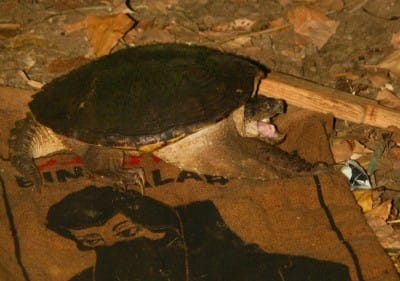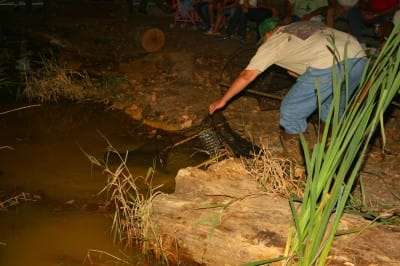
The limber cut pole Grandpa had shoved into the muddy bank, the day before, was nearly bent double. It would relax and then bend double again.
“There’s a big catfish or a big turtle on that line,” he guessed as he rowed the boat to the next line. I squeaked out, “I hope it’s a catfish” scared to death of snapping turtles.
The glimpse of a giant shell sent me scrambling to the other end of the boat. The rough fish we had caught were dumped out of the weathered burlap bag onto the bottom of the boat. The bag was put over as much of the turtle as would fit and the turtle lay on the bottom of the boat, nasty disposition and all.
Grandpa fished for food. To him the snapping turtle was a bonus, fresh turtle meat.
That was more than 35 years ago, and these days turtle fishing or trapping is nearly a forgotten art, but Jerry Schilling of New Harmony, Ind. has been trapping turtles in one manner or another for more than 40 years and is a master of it.
Each year he presents seminars to other turtle trappers and would be trappers.
Ways of the Turtle
Schilling begins making up nets in March.
“Snapping turtles really start moving around good in April as the water warms up,” said Schilling. “They are coming out of hibernation, looking for something to eat, and the females will be looking for territory to lay their eggs, but the males will be moving around just as much as the females.”
To Catch a Snapping Turtle
For Schilling, the art of turtle trapping has been a progressive art. He has used limb lines and jug lines and even noodled them, however, today he uses D hoop turtle nets he constructs and also sells.
“I haven’t used a line in 30 years,” saidSchilling, whose role has changed over the years.
At one time he would keep every turtle, today he seldom keeps a female or a turtle less than 10 pounds.
“I use nets almost exclusively,” saidSchilling. “A net is just a big live trap. You can release or keep only what you want. A hook a lot of times will get swallowed, and you will have to clean the turtles.”
Regardless of the method to catch turtles, Schilling prefers the same baits.

“Fresh fish, and it doesn’t seem to matter what kind,” said Schilling when asked what he uses. “For lines, I used tough stew meat or raw venison scraps. In my nets I’ve used other baits, but fresh fish seems to work the best.”
How to Catch Turtles
Schilling uses 18-inch hoop nets and sets them in shallow water. The larger nets, 24 inch nets, are set in water up to 24 inches deep. Schilling ensures the nets are not fully submerged, so the turtles can get air, and to achieve this he sets his nets close to the bank. Every situation is a bit different.
“If you are trapping them in a river or creek and it has been raining, the water will rise. Make sure the nets aren’t fully submerged. A turtle will surface to get air every hour and half or so,” said Schilling.
Line Fishing
In some states, like Illinois, lines are the only method allowed to fish for turtles. In this case, Schilling recommends a stainless No. 2 hook that won’t bend.
When using lines, Schilling recommends using a tough cut of red meat like an undesirable cut of venison for bait or the head of a bluegill or other bony part of the fish to keep other fish from stealing the bait.
Noodling
“I used to noodle turtles, but it’s tough to carry the turtles and catch them where the turtles like to hang out,” said Schilling. “It’s not the turtles or snakes you need to worry about when you have your hand up under the bank, it’s the muskrats.”
Table Fare
According to Schilling, unlike fish, in which the taste gets stronger as the fish gets larger, he’s never noticed a difference with turtle meat. The meat might get tougher, but in taste there is little difference between a young turtle and an old turtle.
Where to Find Them
Like any predator, a fish or a turtle, cover is the key to locating turtles.
“Look for downed logs in the water or in cattail swamps. Find the nastiest place in the swamp, and that is where they will be,” suggests Schilling. “That is where their prey will be as well, but turtles have to have a place to hide.”

Turtles: Myths and Facts
To determine the sex of a turtle flip it on its shell. “A female’s vent will be directly in-line with the back of the shell, while a male’s vent will be toward the end of the tail.”
Schilling also dispels many myths about turtles.
Myth: If a turtle bites your finger, they won’t release until the sun goes down.
Fact: “If a turtle bites your finger, you ‘ll find a way to get that turtle off quick,” says Schilling.
Myth: A turtle has seven different kinds of meat.
Fact: “A turtle has two kinds of meat; white and dark,” says Schilling. “It does have seven different pieces; four legs, the neck, tail and the loins. At least that’s all I’ve ever found in one.”
Cleaning Turtles
Schilling estimates he has cleaned more than 20,000 snapping turtles. If you have never done it or seen it done, cleaning a turtle can be a daunting, perplexing endeavor, but once you see Schilling clean one, you will be convinced; he knows which end of the turtle to grab.
Schilling has even produced a DVD called “Snapping Turtles from A to Z” where he covers everything a beginner or even a seasoned trapper needs to know to catch, clean and cook turtles.
The Union Sportsmen’s Alliance website is designed to provide valuable articles about hunting, fishing and conservation for members of AFL-CIO affiliated labor unions and all sportsmen and sportswomen who appreciate hunting and fishing and want to preserve our outdoor heritage for future generations. If you would like your own story and experience from the outdoors to be considered for our website, please email us at[email protected]







